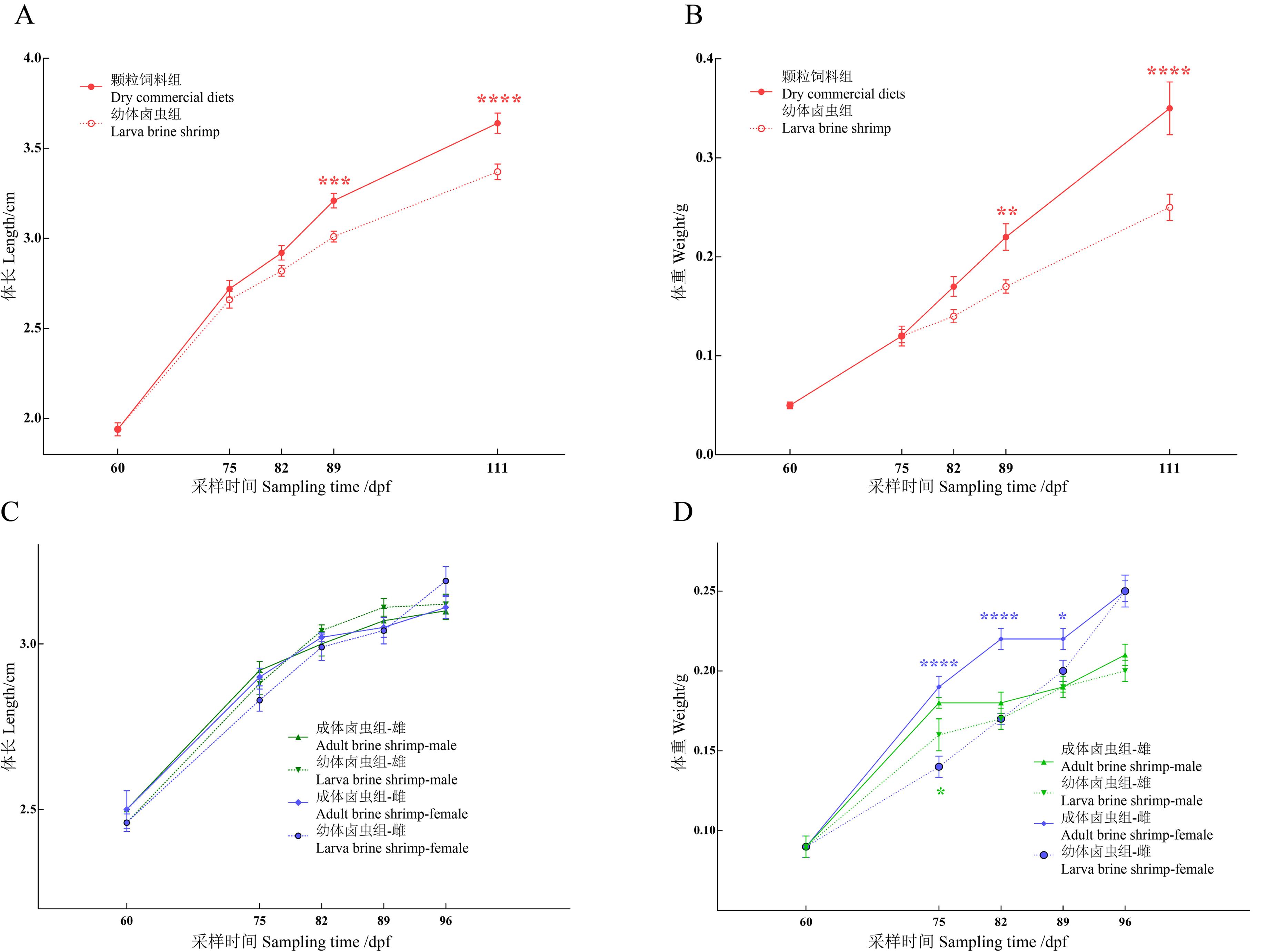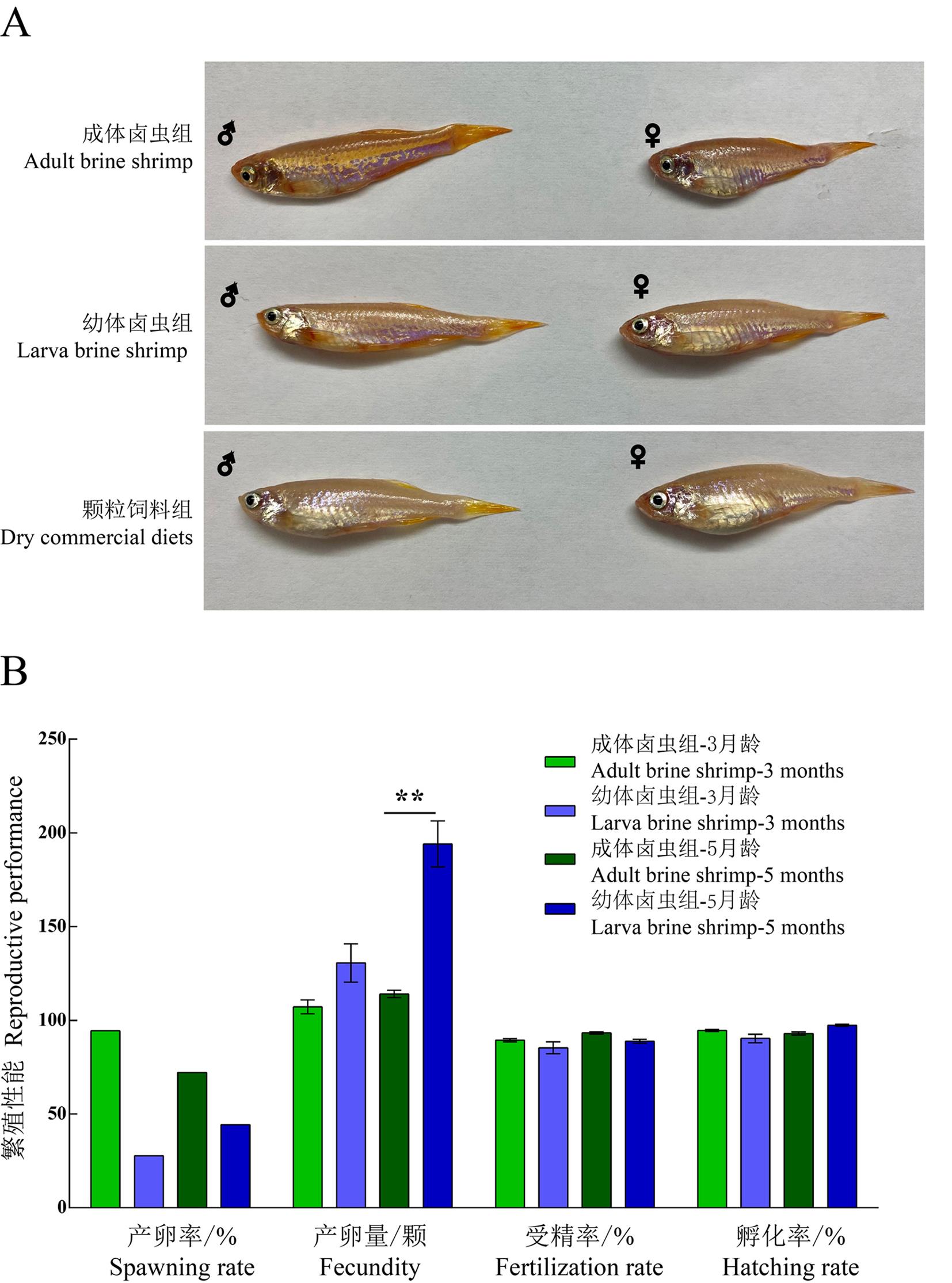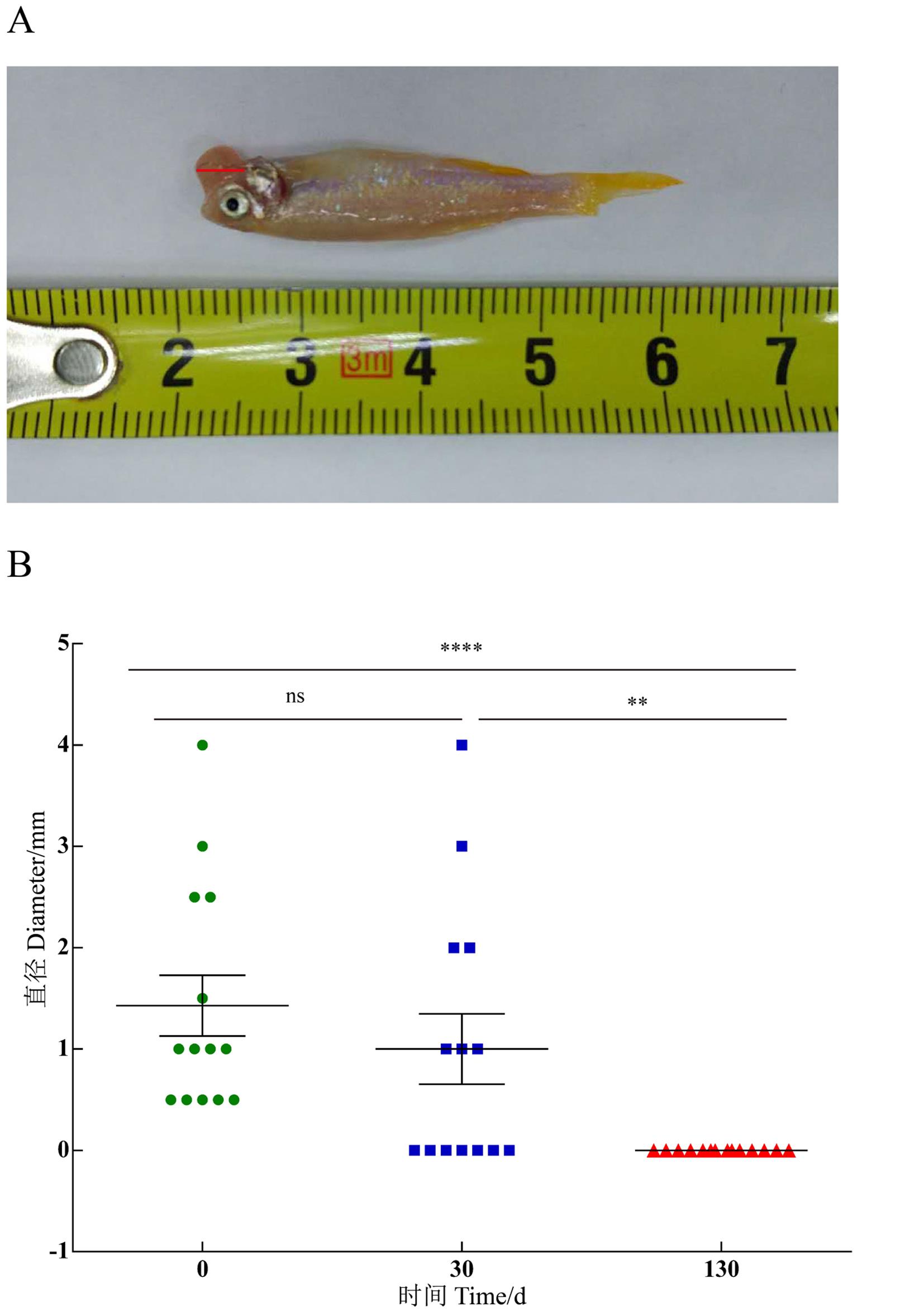
Laboratory Animal and Comparative Medicine ›› 2023, Vol. 43 ›› Issue (3): 297-306.DOI: 10.12300/j.issn.1674-5817.2023.004
• Animal Experimental Techniques and Methods • Previous Articles Next Articles
Shirong JIN1( ), Ye HUA1(
), Ye HUA1( ), Huaxing ZI2, Xufei DU1, Jiwen BU2(
), Huaxing ZI2, Xufei DU1, Jiwen BU2( )(
)( )
)
Received:2023-01-16
Revised:2023-04-18
Online:2023-06-25
Published:2023-06-25
Contact:
Jiwen BU
CLC Number:
Shirong JIN,Ye HUA,Huaxing ZI,et al. An Optimized Experimental Zebrafish Breeding Scheme for Significantly Enhancing Reproductive Efficiency and Service Life[J]. Laboratory Animal and Comparative Medicine, 2023, 43(3): 297-306. DOI: 10.12300/j.issn.1674-5817.2023.004.
Add to citation manager EndNote|Ris|BibTeX
URL: https://www.slarc.org.cn/dwyx/EN/10.12300/j.issn.1674-5817.2023.004
营养成分 Nutrition ingredients | 需求量 Requirement | 幼体卤虫(活) Larva brine shrimp (live) | 成体卤虫(冻) Adult brme shrimp (frozen) | 颗粒饲料1 Dry commercial diets-1 | 颗粒饲料2 Dry commercial diets-2 |
|---|---|---|---|---|---|
| 钙Calcium/% | 0.9~1.6 (斑马鱼)[ | 未检出 | 未检出 | 2.31 | 2.62 |
| 磷Phosphorus/% | 0.8~1.4 (斑马鱼)[ | 0.12 | 0.07 | 1.92 | 2.22 |
| 镁Magnesium/(mg·kg-1) | 600 mg/kg (鲤鱼)[ | 186 | 102 | 6 110 | 5 360 |
| 铁Iron/(mg·kg-1) | 150 mg/kg (鲤鱼)[ | 未检出 | 58.5 | 575 | 940 |
| 硒Selenium/(mg·kg-1) | 0.12 mg/kg (鲤鱼)[ | 0.15 | 0.27 | 3.22 | 4.55 |
| 锌Zinc/(mg·kg-1) | 15~30 mg/kg (鲤鱼)[ | 20 | 5.3 | 160 | 300 |
| 维生素B3 Vitamin B3/(mg·kg-1) | 30~40 mg/kg (鲤鱼)[ | 未检出 | 133 | 未检出 | 未检出 |
| 维生素C Vitamin C/(mg·kg-1) | 30~50 mg/kg (鲤鱼)[ | 50.5 | 102 | 1 000 | 3 960 |
| 维生素B2 Vitamin B2/(mg·kg-1) | 7~10 mg/kg (鲤鱼)[ | 未检出 | 未检出 | 38 | 84.8 |
Table 1 Nutrition ingredients of different diets
营养成分 Nutrition ingredients | 需求量 Requirement | 幼体卤虫(活) Larva brine shrimp (live) | 成体卤虫(冻) Adult brme shrimp (frozen) | 颗粒饲料1 Dry commercial diets-1 | 颗粒饲料2 Dry commercial diets-2 |
|---|---|---|---|---|---|
| 钙Calcium/% | 0.9~1.6 (斑马鱼)[ | 未检出 | 未检出 | 2.31 | 2.62 |
| 磷Phosphorus/% | 0.8~1.4 (斑马鱼)[ | 0.12 | 0.07 | 1.92 | 2.22 |
| 镁Magnesium/(mg·kg-1) | 600 mg/kg (鲤鱼)[ | 186 | 102 | 6 110 | 5 360 |
| 铁Iron/(mg·kg-1) | 150 mg/kg (鲤鱼)[ | 未检出 | 58.5 | 575 | 940 |
| 硒Selenium/(mg·kg-1) | 0.12 mg/kg (鲤鱼)[ | 0.15 | 0.27 | 3.22 | 4.55 |
| 锌Zinc/(mg·kg-1) | 15~30 mg/kg (鲤鱼)[ | 20 | 5.3 | 160 | 300 |
| 维生素B3 Vitamin B3/(mg·kg-1) | 30~40 mg/kg (鲤鱼)[ | 未检出 | 133 | 未检出 | 未检出 |
| 维生素C Vitamin C/(mg·kg-1) | 30~50 mg/kg (鲤鱼)[ | 50.5 | 102 | 1 000 | 3 960 |
| 维生素B2 Vitamin B2/(mg·kg-1) | 7~10 mg/kg (鲤鱼)[ | 未检出 | 未检出 | 38 | 84.8 |

Figure 1 Effects of dry commercial diets and adult brine shrimp on growth of zebrafishNote: Data are presented as means±SEM (n=9). A - B are the body length (A) and body weight (B) changes of zebrafish in dry commercial diets group and larva brine shrimp group (compared with larva brine shrimp group, **P<0.01, *P<0.05). C-D are the changes in body length (C) and body weight (D) of male and female zebrafish in adult brine shrimp group and larva brine shrimp group (compared with male and female zebrafish in larval brine shrimp group, ****P<0.000 1, ***P<0.001, **P<0.01, *P<0.05). dpf, age after fertilization.

Figure 2 Effects of different diets on reproductive characteristics of zebrafishNote: A, the typical appearance of zebrafish (♂ male, ♀ female) in dry commercial diets group, adult brine shrimp group and larva brine shrimp group. B is the comparison of spawning rate, spawning amount, fertilization rate and hatching rate of 3-month-old and 5-month-old zebrafish between adult brine shrimp group and larva brine shrimp group (9 zebrafish in each group. Spawning amount, fertilization rate and hatching rate are presented as means±SEM, **P<0.01).

Figure 3 Effect of dry commercial diets on goiter disease of zebrafishNote: A, Appearance of Zebrafish with goiter; B, Changes in thyroid diameter of Zebrafish after dry commercial diets feeding [Data are presented as means ±SEM (n=15), ?P<0.01, ????P<0.000 1, ns indicated no statistical difference].
| 1 | 李阔宇, 潘鲁湲, 孙永华. 斑马鱼鱼房和养殖系统建设标准[J]. 中国比较医学杂志, 2020, 30(6):121-127. DOI: 10.3969/j.issn.1671-7856.2020.06.018 . |
| LI K Y, PAN L Y, SUN Y H. Standards for constructing zebrafish houses and breeding systems[J]. Chin J Comp Med, 2020, 30(6):121-127. DOI: 10.3969/j.issn.1671-7856.2020.06.018 . | |
| 2 | 国家市场监督管理总局, 国家标准化管理委员会. 实验动物 实验鱼质量控制: [S]. 北京: 中国标准出版社, 2020. |
| State Administration for Market Regulation, China National Standardization Commission. Laboratory animal-Quality control of laboratory fish: [S]. Beijing: China Standards Press, 2020. | |
| 3 | 欧阳娟, 薛松磊, 徐妍, 等. 环境因素对丰年虾孵化的影响及孵化条件优化[J]. 中国饲料, 2018(18): 83-86. DOI: 10.15906/j.cnki.cn11-2975/s.20181817 . |
| OUYANG J, XUE S L, XU Y, et al. The effect of environmental factors on the hatching of Artemia salina and the optimization of hatching conditions[J]. China Feed, 2018(18): 83-86. DOI: 10.15906/j.cnki.cn11-2975/s.20181817 . | |
| 4 | LAWRENCE C. The husbandry of zebrafish (Danio rerio): a review[J]. Aquaculture, 2007, 269(1-4):1-20. DOI: 10.1016/j.aquaculture.2007.04.077 . |
| 5 | 祝梅香, 王天奇, 张长勇, 等. 实验用斑马鱼剑尾鱼营养需求及饲料现状分析[J]. 中国比较医学杂志, 2009, 19(12): 61-65. DOI: 10.3969/j.issn.1671-7856.2009.12.012 . |
| ZHU M X, WANG T Q, ZHANG C Y, et al. Nutritional requirements and current status of diets of laboratory zebrafish and swordtails[J]. Chin J Comp Med, 2009, 19(12): 61-65. DOI: 10.3969/j.issn.1671-7856.2009.12.012 . | |
| 6 | SPENCE R, FATEMA M K, ELLIS S, et al. Diet, growth and recruitment of wild zebrafish in Bangladesh[J]. J Fish Biol, 2007, 71(1):304-309. DOI: 10.1111/j.1095-8649.2007.01492.x . |
| 7 | 何嘉玲, 刘静, 王天奇, 等. 斑马鱼的质量标准化[J]. 中国实验动物学报, 2014, 22(6): 99-102. DOI: 10.3969/j.issn.1005-4847.2014.06.018 . |
| HE J L, LIU J, WANG T Q, et al. Research of zebrafish quality standardization[J]. Acta Lab Animalis Sci Sin, 2014, 22(6): 99-102. DOI: 10.3969/j.issn.1005-4847.2014.06.018 . | |
| 8 | CAHU C, INFANTE J Z. Substitution of live food by formulated diets in marine fish larvae[J]. Aquaculture, 2001, 200(1-2):161-180. DOI: 10.1016/S0044-8486(01)00699-8 . |
| 9 | Baert P, Bosteels T, Sorgeloos P. Manual on the Production and Use of Live Food for Aquaculture [J]. Fao Fisheries Technical Paper, 1996. DOI: http://tailieu.vn/doc/manual-on-the-production-and-use-of-live-f . |
| 10 | 李爱杰. 水产动物营养与饲料学[M]. 北京: 中国农业出版社, 1996. |
| LI A J. Aquatic animal nutrition and Feed science [M]. Beijing: China Agriculture Press, 1996. | |
| 11 | WATTS S A, POWELL M, D'ABRAMO L R. Fundamental approaches to the study of zebrafi sh nutrition[J]. Ilar J, 2012, 53(2):144-160. DOI: 10.1093/ilar.53.2.144 . |
| 12 | 张蓉, 王晓雯, 朱华. 观赏鱼营养需要研究与饲料配制[J]. 中国饲料, 2017(17): 5-9, 17. DOI: 10.15906/j.cnki.cn11-2975/s.20171701 . |
| ZHANG R, WANG X W, ZHU H. Study on nutritional needs of ornamental fish and feed preparation[J]. China Feed, 2017(17): 5-9, 17. DOI: 10.15906/j.cnki.cn11-2975/s.20171701 . | |
| 13 | 王强. 浅谈观赏鱼的配合颗粒饲料[J]. 中国园林, 1992, 8(1):57. |
| WANG Q. 浅谈观赏鱼的配合颗粒饲料[J]. J Chin Landsc Archit, 1992, 8(1):57. | |
| 14 | 汪福保, 罗莉, 王朝明, 等. 鱼类镁营养研究进展[J]. 动物营养学报, 2011, 23(6):930-936. DOI: 10.3969/j.issn.1006-267X.2011.06.007 . |
| WANG F B, LUO L, WANG C M, et al. Recent advances in magnesium nutrition of fish[J]. Acta Zoonutrimenta Sin, 2011, 23(6):930-936. DOI: 10.3969/j.issn.1006-267X.2011.06.007 . | |
| 15 | 梁德海. 鱼类对矿物质的营养需要及其缺乏症[J]. 饲料工业, 1998,019(10):25-26. DOI: CNKI:SUN:FEED.0.1998-10-012 . |
| LIANG D H. Nutritional requirement of fish for minerals and its deficiency[J]. Feed Ind, 1998(10):25-26. DOI: CNKI:SUN:FEED.0.1998-10-012 . | |
| 16 | 吴云发, 方春林, 王庆萍. 鱼类矿物质营养研究进展[J]. 江西水产科技, 2007(4): 19-22. DOI: 10.3969/j.issn.1006-3188.2007.04.007 . |
| WU Y F, FANG C L, WANG Q P. Research progress of mineral nutrition in fish[J]. Jiangxi Fish Sci Technol, 2007(4): 19-22. DOI: 10.3969/j.issn.1006-3188.2007.04.007 . | |
| 17 | 韩如政. 维生素对鱼类的营养作用及在饲料中的添加[J]. 饲料工业, 1989(9):34-36. |
| HAN R. 维生素对鱼类的营养作用及在饲料中的添加[J]. Feed Ind, 1989(9):34-36. | |
| 18 | 曹洪泽, 胡旭辉, 杨树娥. 卤虫的生活习性及其养殖技术[J]. 河北渔业, 2003(4): 45-46. DOI: 10.3969/j.issn.1004-6755.2003.04.027 . |
| CAO H Z, HU X H, YANG S E. Life habits and culture techniques of Artemia[J]. Hebei Fish, 2003(4): 45-46. DOI: 10.3969/j.issn.1004-6755.2003.04.027 . | |
| 19 | 张宏, 陈燕琴. 卤虫的饵料价值与选用[J]. 青海师范大学学报(自然科学版), 2009, 25(1):67-71. DOI: 10.3969/j.issn.1001-7542.2009.01.019 . |
| ZHANG H, CHEN Y Q. Feed value and select application of Artemia[J]. J Qinghai Norm Univ Nat Sci Ed, 2009, 25(1):67-71.DOI: 10.3969/j.issn.1001-7542.2009.01.019 . | |
| 20 | 郑新春, 刘莉, 戴文聪, 等. 过度喂养建立斑马鱼幼鱼肥胖模型[J]. 南方医科大学学报, 2016, 36(1):20-25. DOI: 10.3969/j.issn.1673-4254.2016.01.04 . |
| ZHENG X C, LIU L, DAI W C, et al. Establishment of a diet-induced obesity model in zebrafish larvae[J]. J South Med Univ, 2016, 36(1):20-25. DOI: 10.3969/j.issn.1673-4254.2016.01.04 . | |
| 21 | IZQUIERDO M S, FERNÁNDEZ-PALACIOS H, TACON A G J. Effect of broodstock nutrition on reproductive performance of fish[M] // Reproductive Biotechnology in Finfish Aquaculture. Amsterdam: Elsevier, 2001:25-42. DOI: 10.1016/b978-0-444-50913-0.50006-0 . |
| 22 | 王梅, 张永勤, 黄靖, 等. 红斑马鱼体色观察及敲除mitfa基因对其体色发育的影响[J]. 激光生物学报, 2022, 31(1):19-26. DOI: 10.3969/j.issn.1007-7146.2022.01.004 . |
| WANG M, ZHANG Y Q, HUANG J, et al. Observation of red zebrafish body color and the effects of knocking out mitfa gene on its body color development[J]. Acta Laser Biol Sin, 2022, 31(1):19-26. DOI: 10.3969/j.issn.1007-7146.2022.01.004 . | |
| 23 | LECLERCQ E, TAYLOR J F, MIGAUD H. Morphological skin colour changes in teleosts[J]. Fish Fish, 2009, 11(2):159-193. DOI: 10.1111/j.1467-2979.2009.00346.x . |
| 24 | GOODWIN T. The biochemistry of the carotenoids: volume Ⅱanimals[M/OL]. 2nd ed. New York: Chapman and Hall, 1984. . |
| 25 | 曹天义, 景晓娜. 人工投喂饵料提高卤虫养殖单产的探究[J]. 水产养殖, 2020, 41(12):40-41, 44. |
| CAO T Y, JING X. 人工投喂饵料提高卤虫养殖单产的探究[J]. J Aquac, 2020, 41(12):40-41, 44. | |
| 26 | 林小涵, 金超凡, 高晨, 等. MiR-430对斑马鱼原始生殖细胞迁移和性腺发育影响的初步研究[J]. 中国海洋大学学报(自然科学版), 2022, 52(3):72-79. DOI: 10.16441/j.cnki.hdxb.20210144 . |
| LIN X H, JIN C F, GAO C, et al. Preliminary functional analysis of miR-430 in regulating zebrafish (Danio rerio) primordial germ cell migration and gonad development[J]. Period Ocean Univ China, 2022, 52(3):72-79. DOI: 10.16441/j.cnki.hdxb.20210144 . | |
| 27 | 郭盼, 周继术, 吉红, 等. 不同链长脂肪酸对斑马鱼的性腺脂肪酸组成、繁殖力与仔鱼成活率的影响[J]. 水生生物学报, 2017, 41(4):766-773. DOI: 10.7541/2017.95 . |
| GUO P, ZHOU J S, JI H, et al. Influence of fatty acids with different chain length on fatty acid composition of ovaries, fecundity and survival rate of larvae in zebrafish (Danio rerio)[J]. Acta Hydrobiol Sin, 2017, 41(4):766-773. DOI: 10.7541/2017.95 . | |
| 28 | MURRAY K N, WOLF J C, SPAGNOLI S T, et al. Reversibility of proliferative thyroid lesions induced by iodine deficiency in a laboratory zebrafish colony[J]. Zebrafish, 2018, 15(6):558-565. DOI: 10.1089/zeb.2018.1603 . |
| 29 | D'ABRAMO L. Challenges in developing successful formulated feed for culture of larval fish and crustaceans[J]. Avances en Nutrición Acuícola Ⅵ, 2002, 143–151. |
| [1] | ZHAO Xin, WANG Chenxi, SHI Wenqing, LOU Yuefen. Advances in the Application of Zebrafish in the Research of Inflammatory Bowel Disease Mechanisms and Drug Development [J]. Laboratory Animal and Comparative Medicine, 2025, 45(4): 422-431. |
| [2] | Dong WU, Rui SHI, Peishan LUO, Ling'en LI, Xijing SHENG, Mengyang WANG, Lu NI, Sujuan WANG, Huixin YANG, Jing ZHAO. Effects of Different Pellet Feed Hardness on Growth and Reproduction, Feed Utilization Rate, and Environmental Dust in Laboratory Mice [J]. Laboratory Animal and Comparative Medicine, 2024, 44(3): 313-320. |
| [3] | Jinxing LIN, Xindong WANG, Xuebing BAI, Liping FENG, Shuwu XIE, Qiusheng CHEN. Fine Structure of the Trunk Kidney and Distribution of Its Secreted Exosomes in the Adult Zebrafish [J]. Laboratory Animal and Comparative Medicine, 2023, 43(5): 531-540. |
| [4] | Jinxian YANG, Shujuan WANG, Jinyun ZHAI, Shunxing ZHU. Downregulation of Micall2a Gene Expression Inhibited Vascular Development in Zebrafish [J]. Laboratory Animal and Comparative Medicine, 2023, 43(3): 282-287. |
| [5] | Zhigang TAN, Jinxin LIU, Chuya ZHENG, Wenfeng LIAO, Luping FENG, Hongli PENG, Xiu YAN, Zhenjian ZHUO. Advances and Applications in Animal Models of Neuroblastoma [J]. Laboratory Animal and Comparative Medicine, 2023, 43(3): 288-296. |
| [6] | Qiwen HU, Zheng BI, Haiping LIU, Zhihua DONG, ZHUYanlin, Jinhua WANG. Research Progress on Animal Models of Intrauterine Growth Restriction [J]. Laboratory Animal and Comparative Medicine, 2022, 42(5): 423-431. |
| [7] | Huijie GONG, Guangming ZHANG. Effects of Inagliptin on the Expression of Periosteal and TGF-β1 in Renal Fibrosis of Type 2 Diabetic Rats [J]. Laboratory Animal and Comparative Medicine, 2022, 42(2): 135-140. |
| [8] | JIANG Xia, QIAN Haojie, WEI Xun, ZHENG Yuxuan, ZHOU Zhengyu. Research Progress in Construction and Application of Diabetes Model in Zebrafish [J]. Laboratory Animal and Comparative Medicine, 2020, 40(6): 547-552. |
| [9] | FAN Shuqiong, ZHENG Li. Exploration of Phospho-HER2 Immunohistochemistry Staining on Frozen Tumor Tissues [J]. Laboratory Animal and Comparative Medicine, 2020, 40(5): 426-. |
| [10] | DI Yanan, ZHU Liying, QIAN Wen, PAN Wei. Application of Zebrafish as A Model Animal in Research of Human Eye Diseases [J]. Laboratory Animal and Comparative Medicine, 2020, 40(5): 440-. |
| [11] | WANG Xue, LIU Kechun, YANG Xueliang, MA Yukui, ZHANG Yun. Impacts of Okadaic Acid on Neurological Function and Behavior of Zebrafish Larvae#br# [J]. Laboratory Animal and Comparative Medicine, 2020, 40(3): 190-. |
| [12] | Li Ying-niang, Dai Wei, Sheng Jian. Analysis of Goiter in Zebrafish [J]. Laboratory Animal and Comparative Medicine, 2019, 39(6): 462-466. |
| [13] | XU Xing-jun, WU Fei, SONG Jin-yi, GAO Shi-le. Effects of Proanthocyanin on Expression of IL-1, TGF-β1 and NF-Kappa B Proteins in Rats with Radiation-induced Heart Disease [J]. Laboratory Animal and Comparative Medicine, 2019, 39(5): 383-389. |
| [14] | MA Jun, LUO Jun-dong, JING Wen-jiang, ZHANG Shu-lian, WANG Juan-yi, FAN Zhi-gang. Investigation on Radiosensitivity Impact of Lung Cancer A549 Cells by Vascular Endothelial Growth Factor Silencing in vivo [J]. Laboratory Animal and Comparative Medicine, 2019, 39(4): 280-286. |
| [15] | WANG Li-mei, ZHANG Jian, LIU Zhong-hua, YANG Wei. Research Progress on Zebrafish Model of Retinoblastoma and rb1 Gene [J]. Laboratory Animal and Comparative Medicine, 2019, 39(3): 244-248. |
| Viewed | ||||||
|
Full text |
|
|||||
|
Abstract |
|
|||||